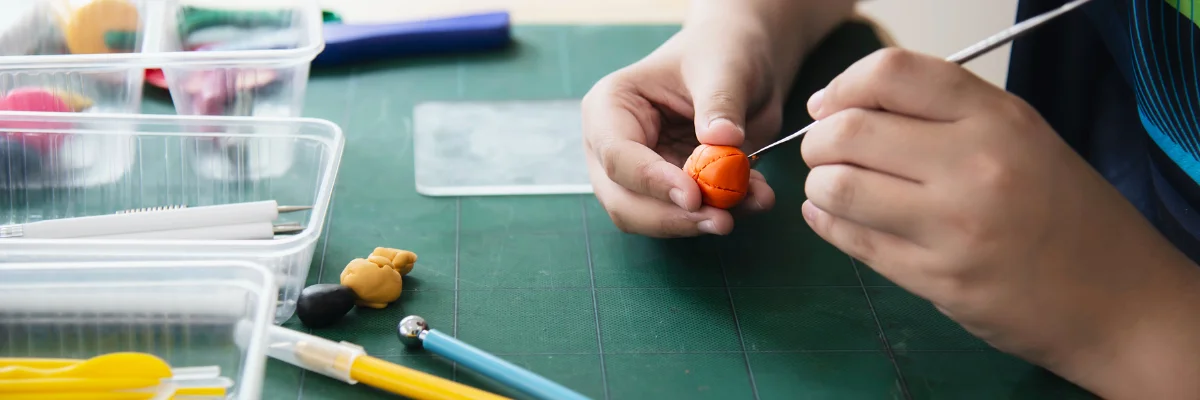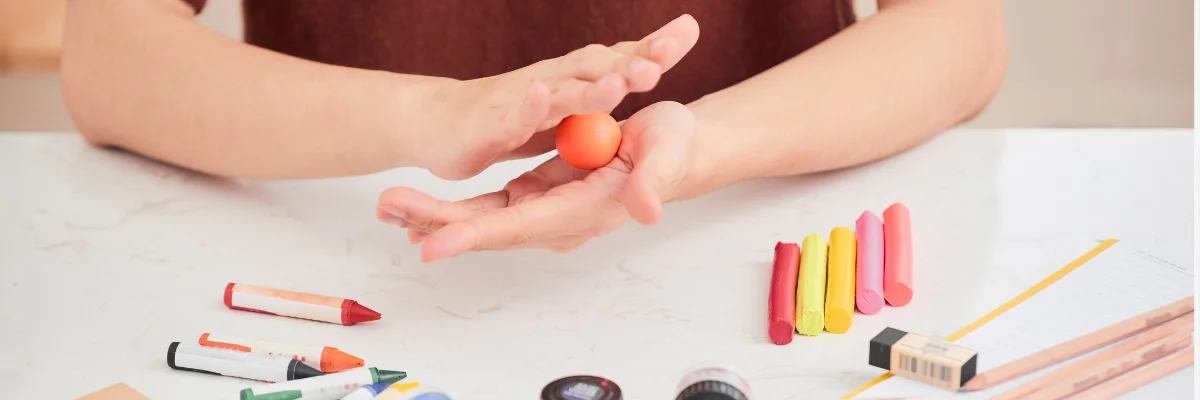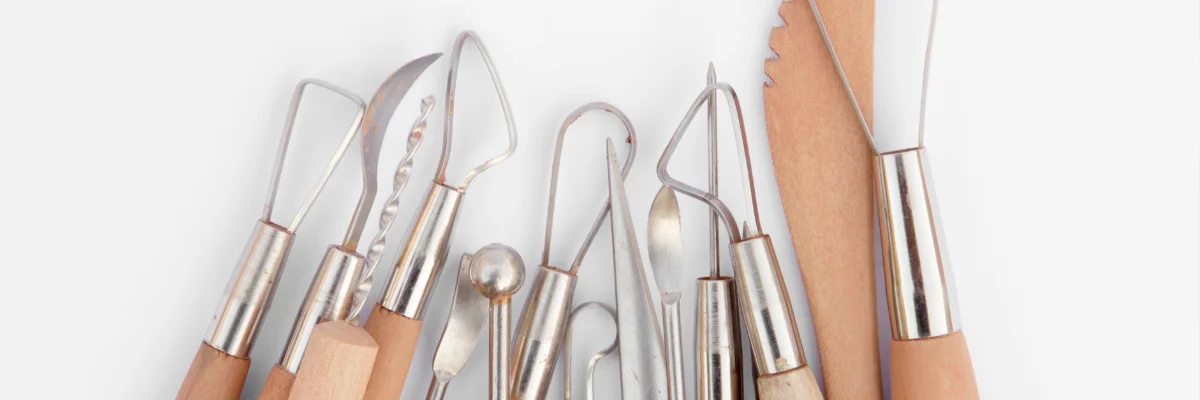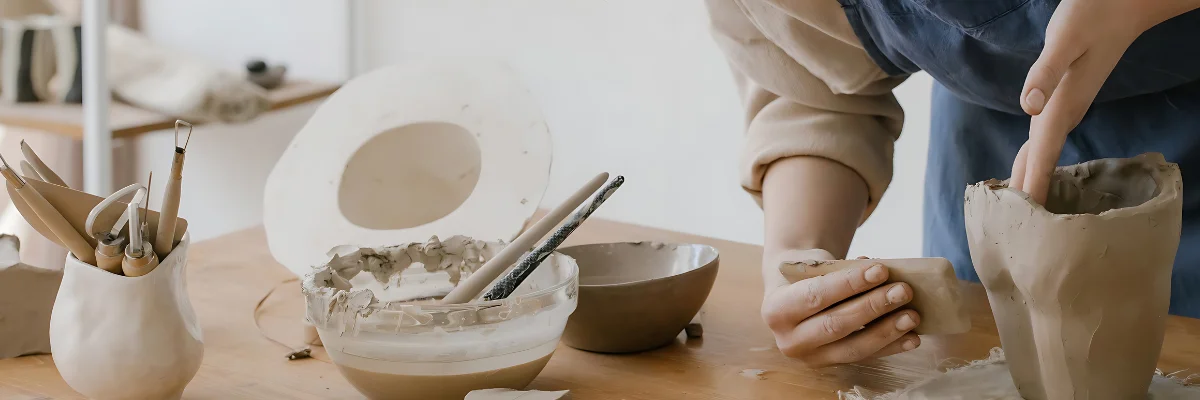
Air Dry Clay Basics
Introduction to Air Dry Clay
Welcome to the whimsical world of air dry clay sculpture, where the only limit is your imagination (and perhaps your supply of cling wrap). Air dry clay is a pliable and charming sculptural medium that caters to artists who prefer to dodge the fiery furnace of a kiln. It’s perfect for those spontaneous bursts of creativity—just knead, shape, and voilà, you’ve got yourself a masterpiece in the making! No need for an oven, this clever clay simply dries by waving goodbye to the water molecules as they disappear into the wild yonder of your craft room.
Properties of Air Dry Clay
Now, let’s chat about what makes air dry clay the go-to for crafty souls and sculpture enthusiasts. This nifty material has an almost magical ability to dry to a sturdy earthenware hardness after a mere 24 hours of lounging around at room temperature. It’s a patient medium, allowing you to sand, paint, or seal it to your heart’s content once it’s dry (Prima).
| Properties | Description |
|---|---|
| Drying Time | Approximately 24 hours |
| Texture | Soft and smooth post-kneading |
| Hardness | Dries to earthenware hardness |
| Workability | Remains pliable for ~4 days if kept moist |
| Safety | Non-toxic but not food-safe |
And here’s a fun fact: while it may not be fond of water post-drying (it’s not food-safe and despises dishwashers), you can keep air dry clay malleable for an extended sculpting session. Just tuck it into a damp tea towel and embrace it with cling wrap like a culinary burrito. This will keep your clay ready for action for up to four days (Mont Marte).
It’s a joy to work with, especially if you’re a bit spongy yourself. Its composition is forgiving, making it a dream for both nimble-fingered children and bright-eyed beginners. Plus, if you’re dreaming of crafting a colossus, air dry clay is your ally—it doesn’t require an oven, so you can go as grand as you please! Once you’ve finished sculpting, a glaze can be the knight in shining armour that makes your creation as durable as your love for art (Sculpey).
Venture on, intrepid artist, and may your air dry clay escapades be as boundless as your creativity! For more inspiring air dry clay ideas and modelling techniques, be sure to explore further.
Working with Air Dry Clay
When it comes to the whimsical world of sculpting, air dry clay swoops in like a superhero for artists and hobbyists who lack the patience for the rigmarole of firing kilns. Let’s dive into how one can become a maestro of this malleable medium.
Techniques for Shaping and Sculpting
Before one can begin the grand performance of shaping and sculpting, a good warm-up is essential. That means kneading your air dry clay until it’s as pliable as a gymnast (Mont Marte). Once it’s warmed up and ready, it’s time to get creative!
- Coiling: Like a snake charmer, you can coax the clay into long ropes, wrapping them around to build pots, vases, and more.
- Pinching: Not just for cheeky aunts, pinching can be used to create bowls and other objects by carefully moulding the clay with your fingers.
- Slabbing: Roll out the clay like a pie crust and cut it into shapes to assemble into structures.
Remember, this isn’t a sprint; take your time to smooth out the creases and blend the joints. Air dry clay can be a diva, prone to cracking if stretched too thin, so keep those sculptures chunky and cheerful (Prima).
Tips for Handling Air Dry Clay
To prevent a tragic end to one’s sculptural saga, here are some top tips for handling air dry clay:
- Conditioning: Give your clay a good massage before you start; it’s a great stress-buster for both of you!
- Non-stick surface: Work on a surface that won’t cling to the clay, like a texture-free silicone mat or wax paper.
- Keep it moist: If the clay starts to dry out during your artistic endeavours, a little spritz of water will rekindle the romance.
- Scoring and slipping: When joining two pieces, score the surfaces and apply a bit of water or slip (a mixture of clay and water) to ensure they stick together like best pals.
- Dry thoroughly: Patience is a virtue. Let your masterpiece dry for around 24 hours in peace, away from the temptation to poke and prod (Prima).
Once your creation is drier than a British sense of humour, it’s ready for painting or sealing. And there you have it! You’re now equipped to handle air dry clay like a pro. For more inspiration, check out some air dry clay ideas and get your hands dirty (figuratively, of course). And if you fancy delving into more detailed methods, give air dry clay modelling a gander. Happy sculpting!
Air Dry Clay Projects
Unleash your inner Michelangelo—or should we say, your inner Michel-clay-gelo? Dive into the delightful world of air dry clay, where the only limit is your imagination (and possibly the size of your crafting table).
Creative Ideas for Air Dry Clay
For those looking for inspiration faster than a rolling pin in a clay-throwing contest, here are some whimsical ideas to get your creative cogs turning:
- Nature-Inspired Trinket Dishes: Perfect for holding your keys or that collection of pebbles you swear are precious.
- Handprint Decorations: Because who wouldn’t want a high-five hanging on their wall?
- Clay Scent Diffusers: They’re like potpourri’s trendy cousin.
- Colorful Clay Confetti: For that party you definitely plan to vacuum after.
- Coasters: To keep your tables stain-free and your guests impressed.
- Pots: No promises on the plant’s survival, but at least it’ll have a stylish home.
- Stamped Clay Decorations: Get your stamp of approval on literally everything you create.
For more fantastical air dry clay ideas, including how to execute them with flair, be sure to check out our treasure trove of projects.
Step-by-Step Clay Sculpting
Let’s roll up those sleeves (figuratively, if you’re in a strappy top) and get down to the nitty-gritty:
- Knead for Need: Give that clay a good kneading, like you’re prepping for the world’s smallest bread loaf. You want it smoother than a jazz singer’s voice.
- Build It Up: Whether you’re crafting a mini sphinx or a toothbrush holder, it’s all about shaping that potential masterpiece.
- Patience, Grasshopper: Allow your creation to dry in the air for about 24 hours—no ovens, no fuss, no muss (Mont Marte).
Remember, while air dry clay might feel like the superhero of clays with its spongy, easy-to-mold texture, it can still be kryptonite to water—so keep those finished projects away from the wet stuff, unless you fancy a clay soup (Susie Benes).
For a detailed guide on crafting your first (or fiftieth) air dry clay masterpiece and to become a wizard at air dry clay modelling, check out our step-by-step tutorials that’ll have you sculpting like a pro in no time.
Air Dry Clay Brands
Choosing the right brand of air dry clay can be the difference between a sculpture that’s the toast of the town and one that’s… well, just toast. In the world of air dry clays, two brands stand out for their uncanny ability to transform the most whimsical ideas into tangible art: Jovi and Mungyo. Let’s dive into what makes these clays the crème de la crème for your crafting escapades.
Jovi Air Dry Clay
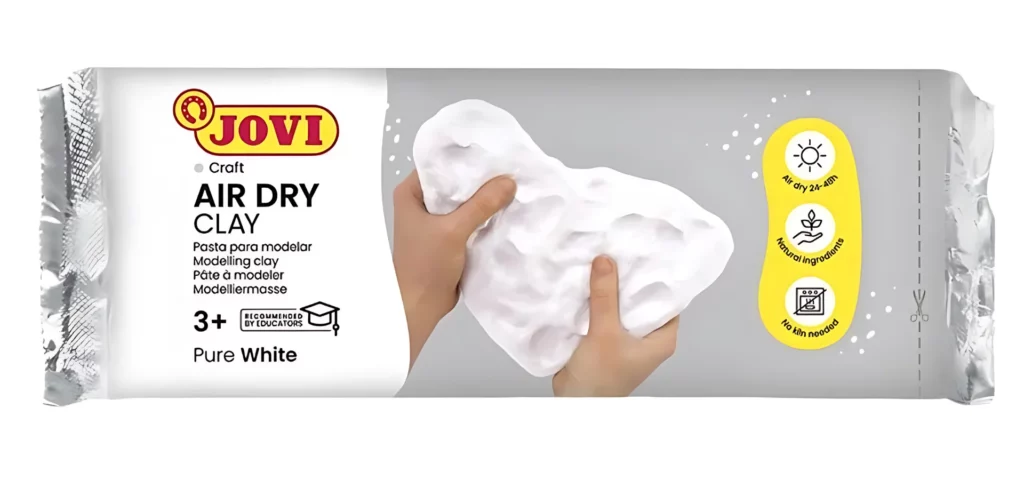
Jovi Air Dry Clay is like the superhero of the modeling world – it sticks to almost anything faster than a speeding bullet! It boasts a cool and pleasant touch, which is a joy for the fingers of artists as they shape their masterpieces. This clay doesn’t just adhere to your expectations; it sticks to wood, plastic, cardboard, glass, and even metal – talk about being versatile!
Jovi Air Dry Clay doesn’t need a fancy high-temperature oven to set. It’s air-dry, remember? Within a mere 24 hours, depending on how thick your sculpture is, it’s ready for its grand unveiling. The clay’s finish is smoother than a jazz singer’s voice, making it a perfect canvas for artists to unleash their creativity using water-based paint, acrylics, or varnish (My Art Shop).
Here’s the lowdown on Jovi Air Dry Clay:
| Quality | Description |
|---|---|
| Texture | Cool and pleasant to touch |
| Adhesion | Sticks to a variety of surfaces |
| Drying Time | 24 hours approx. |
| Finish | Smooth, paintable surface |
For more air dry clay ideas using Jovi, check out our treasure trove of inspirations!
Mungyo Sculpt Dry Clay
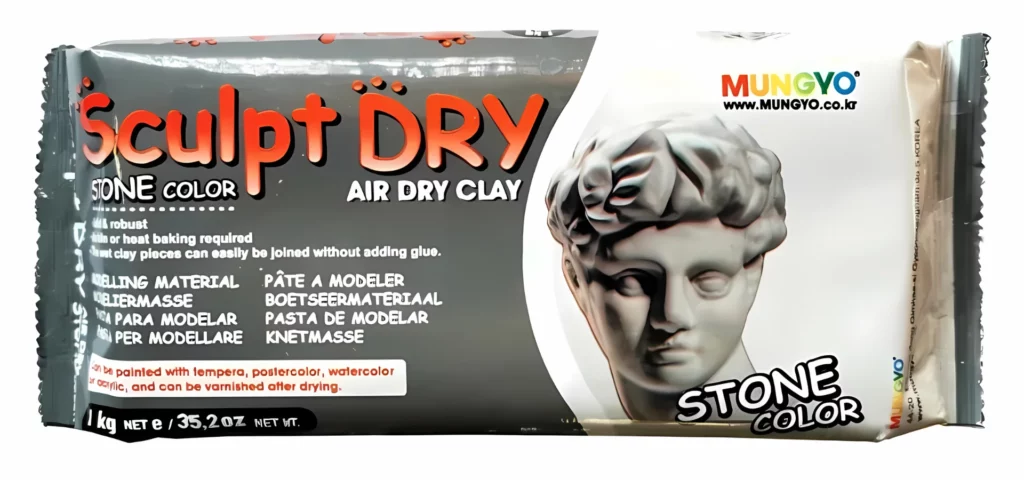
If you’re in the market for a clay that’s as adaptable as a chameleon, Mungyo Sculpt Dry Clay should be your go-to. Fancy rolling it out like a pizza base? Go for it. Want to stamp it, press it, cut it, or hand-form it into something spectacular? You can do all that, too.
This clay is all about giving artists the freedom to sculpt whatever pops into their heads. it’s as sweet a deal as you can get for high-quality clay (My Art Shop).
Grab your sculpting tools and take a peek at the Mungyo Sculpt Dry Clay features:
| Feature | Benefit |
|---|---|
| Versatility | Roll, stamp, mold, sculpt |
| Freedom | No high-temperature oven needed |
Keen to start a project with Mungyo? Swing by our air dry clay modelling page for some stellar tips and tricks!
Whether you fancy the cool touch of Jovi or the all-round flexibility of Mungyo, these brands will help your air dry clay sculpture take flight. So, grab a block of your chosen clay and let your creative spirit soar!
Maintenance and Storage
When you’ve finished crafting your latest air dry clay sculpture, don’t just toss your leftover clay into the abyss of your craft drawer. Proper maintenance and storage are key to keeping your clay in tip-top condition for future masterpieces!
Storing and Reusing Air Dry Clay
Firstly, let’s talk about the leftovers. We all have them, and they’re not just for Christmas. Leftover air dry clay can go from a sculptor’s delight to a crumbly nightmare if not treated with a little TLC. To prevent your clay from becoming as dry as a British comedian’s wit, follow these steps:
- Break it down: If the clay has already started to dry out, break it into smaller pieces. Channel your inner karate master (hi-yah!) but maybe don’t chop it.
- Bag it up: Seal the clay in a zip-lock bag with a smidgen of water. Think of it as a mini spa for your clay.
- Let it rest: Leave it for two days. This is the clay’s version of a weekend getaway.
- Knead for life: After its mini-break, knead the clay until it’s smooth again. It’s a workout for your hands and therapy for the clay.
Remember, unused clay should be treated like a precious treasure. Store it in an airtight container or a zip-lock plastic bag to keep it from drying out. If you’ve got unopened packages, and you’ve gone a bit clay-crazy buying in bulk, extend their shelf life by placing them in an airtight container as well.
Preventing Cracks and Damage
Cracks in your air dry clay can be more frustrating than a plot twist in a soap opera. To avoid such drama, here are a few tips to keep your sculptures looking as smooth as a jazz musician’s tunes:
- Slow and steady: The key to preventing cracks is to slow down the drying process. Think of it as aging a fine wine rather than a quick microwave meal.
- Cool and humid: Store your projects in a place that’s cooler than a cucumber and as humid as a tropical paradise. Good ventilation is also a plus.
- Patch it up: If you do spot a crack, don’t panic. Fill it in with a mixture of wet clay—it’s like the clay equivalent of spackle.
By keeping these tips in mind, your air dry clay will be ready for action whenever inspiration strikes. And if you’re on the hunt for new ideas, why not check out our treasure trove of air dry clay ideas? Or maybe you’re keen to improve your air dry clay modelling techniques? Either way, with proper care, your air dry clay can be the gift that keeps on giving!
Comparing Clay Types
Diving into the wonderful world of clay can sometimes feel like a wild romp through a potter’s pantry. Let’s throw on our creative aprons and compare two heavyweight contenders in the ring of sculpture: polymer clay and air dry clay.
Polymer Clay vs. Air Dry Clay

For starters, polymer clay is like the chameleon of the clay world, available in more pre-made colours than a rainbow after a storm. It maintains its shape like a well-trained gymnast and offers sturdier finished pieces that remain slightly flexible, much like a rubber band refusing to snap.
In contrast, air dry clay is more like that squishy stress ball you can’t stop squeezing. It’s easier to manipulate because of its spongy composition, making it a hit with children and beginners or anyone who prefers not to sweat over their sculptures. Air dry clay is your go-to for larger-than-life projects that scoff at the mere idea of fitting in an oven and doesn’t require any fancy schmancy tools. It’s a champion of durability, especially when sealed with a glaze, and can create long-lasting projects that will see you through many art exhibitions.
While air dry clay dries at room temperature, waving a cheery goodbye to kilns and ovens, polymer clay needs a good bake to harden. Though, be warned, air dry clay might shrink a tad during its drying spell, unlike polymer clay, which holds its shape like a stubborn mule.
Choosing the Right Clay Brand
When selecting the best brand for your air dry clay sculpture, consider it akin to picking a sidekick for your superhero adventures. Each brand boasts its unique superpowers, from modelability to moisture content and final finish characteristics like hardness and shock resistance.
For more insight on handling different brands and types of air dry clay, plus a treasure trove of air dry clay ideas and modelling techniques, be sure to explore our other articles. Happy sculpting, and may your clay choices be as inspired as your art!

